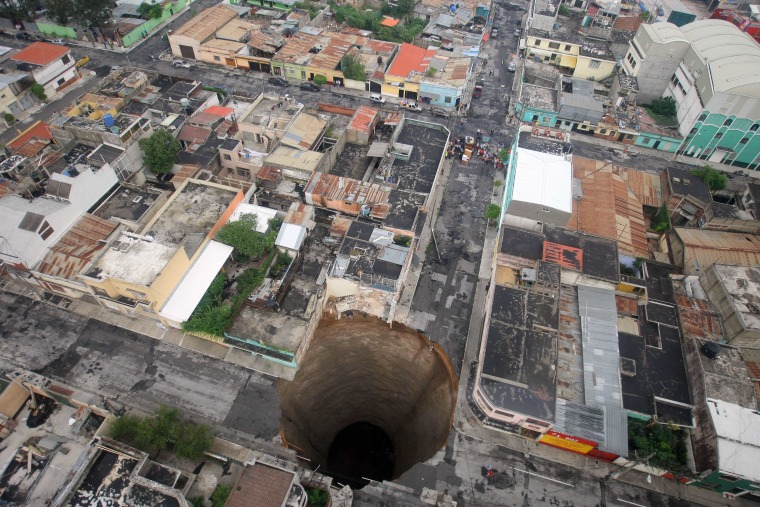
A Florida man is missing after an apparent sinkhole opened in his bedroom in the middle of the night, sucking him and his bed deep into the earth. As frightening as it sounds, sinkholes happen all the time, according to geologists. Usually, though, they are slow-motion processes that can take years.
Sinkholes of the sort that swallowed the Florida man form when slightly acidic groundwater dissolves limestone or similar rock that lies beneath the soil creating a large void or cavities. When the overlying ceiling can no longer support the weight of the soil and whatever is on top of it, the earth collapses into the cavity.
"Then you have the depression at the land surface, which is the sinkhole," Jonathan Arthur, director of the Florida Geological Survey, told NBC News.
If a house or road sits on top of the sinkhole, it too falls into the earth, as did the Florida man who fell into a hole estimated at 20-feet-deep by 20-feet-wide.
"They heard a sound they described as a car crash emanating from the bedroom," Hillsborourgh County Fire Chief Ron Rogers said at a Friday morning news conference describing the reaction of the man's family. “They rushed in. All they could see was part of a mattress sticking out of the hole. The floor of the room had opened."
Technically, the event in Tampa has not been ruled a sinkhole, "although that is what most people believe it to be," Arthur said. "A little further site geology and geotechnical work would be needed to absolutely confirm its nature."
These types of sudden sinkholes are so-called cover-collapse sinkholes. When they occur, a hole typically forms and grows over a period of minutes to hours. Sediments may continue to slump down the sides of the sinkhole for several days and erosion of the edges can last even longer.
At the apparent sinkhole near Tampa the victim "could be drawn into the water with the debris falling on top of him, so he wouldn't be able to possibly escape from that," Grenville Draper, a professor in the department of Earth and the environment at Florida International University, told NBC News.
"That part of it is very tragic," he added. "I've never heard of there being a fatality associated with these before. They do occur rather suddenly, but we're not talking like an earthquake. You do have minutes or even an hour to take action to save yourself."
Cover-collapse sinkholes are quite rare, according to the Florida Sinkhole Research Institute. A preliminary assessment of 1,400 sinkholes found only or two. More common is the slow, gradual subsidence of land, forming bowl-shaped depressions at the surface in a process than can last years.
Sinkholes can reach more than 100 feet deep into the earth and spread across several hundred feet. Others are tiny — a few feet across and maybe a foot deep. Some hold water and form ponds.
"A very small percentage of sinkholes that form actually have some adverse effect on human life and infrastructure," Arthur said. "However, it is those that make the news, whether it is under a roadway or a home."
In addition to Florida, other U.S. hotspots for sinkholes include Texas, Alabama, Missouri, Kentucky, Tennessee and Pennsylvania, according to the U.S. Geological Survey.
Just because one sinkhole opens, does not necessarily mean another nearby is imminent. They are usually isolated events, the Florida Geological Survey notes. However, certain events such as a hurricane following a period of drought can trigger a series of sinkholes to occur within minutes to hours of each other, Arthur noted.
This happened in the wake of Tropical Storm Debby in June 2012. "It came across Florida after a period of drought where water levels in the ground were lower and then we had the massive influx of rain, over 20 inches in some areas, and that change in the climate and the groundwater levels triggered hundreds of sinkholes across the state over a very, very short period of time," Arthur said.
Human activity can also cause sinkholes to develop. Excessive pumping of groundwater, for example, can cause the soil to settle. Others form under the weight of runoff-storage ponds, which cause the underground support material to collapse.
John Roach is a contributing writer for NBC News. To learn more about him, check out his website.